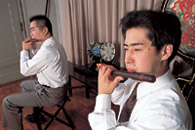 |
|
NIPPONIA No.22 September 15, 2002
|
|
Special Feature*
|
Gagaku
Written by Sakata Shuji
Photos by Omori Hiroyuki
Other photo credits: Shimonaka Memorial Foundation
Gagaku, the music and dance of the Japanese imperial court, is Japan's oldest performing art. A kangen ensemble (wind and strings) accompanies the dance. The main instruments are yokobue (a flute blown from the side), sho (a type of panpipe), hichiriki (an oboe-like pipe), biwa (a short-necked lute), so (a plucked zither), and taiko (a drum).
|
|

The kangen ensemble plays the world's oldest orchestral music.
|
Gagaku developed about 1,300 years ago as a performing art for the Japanese imperial court, blending different styles of music and dance — some from continental Asia coming via China and the Korean peninsula, others from Japan. Gagaku has changed very little over the centuries, and is one of the most unique traditional performing arts in the world.
Almost all gagaku performances were part of a court event, so only a very small number of Japanese had the opportunity to watch them. But this changed recently, and performances are now given for the general public as well.
The court gagaku traditions are kept alive by musicians attached to the Music Department of the Imperial Household Agency's Board of the Ceremonies. Apprentices must pass an exam before they can enter the Department. After seven years gaining knowledge and studying technique, they are formally named to the position of court musician. Almost everyone who strives to become a court performer is closely connected to the Music Department through a relative, perhaps an immediate family member.
Okubo Yasuo plays the yokobue transverse flute and has qualified as a court musician. He is now 27. His father is also a court musician and influenced him greatly. "I first decided to get into gagaku because I wanted to do what my father was doing. In the future, I'd like to perform with him and my younger brother, who is still an apprentice."
The Music Department's primary aim is to preserve gagaku as a performing art. The dance and music styles, and the designs of the costumes, instruments, masks and other props, remain alive today as part of the heritage of ancient Asian cultures. Tangible and intangible elements of gagaku are priceless assets from the past, and it is very important that they are passed on to future generations unchanged.
Iwanami Taka'aki (29) is another yokobue player. "These are 1,300 year-old traditions, so we can't simply decide to change them. We are stepping stones for them as they travel through time."
It's all rather mind-boggling — the history of gagaku is so old, and these performers' goal is so unique. But they aren't over-awed by their role. "I've never been particularly aware that my performance is following ancient traditions — it's just part of my day. My favorite music is hip-hop. I'm no different from the next guy," says Masuyama Seiichi, a 22-year old sho player.
Okubo and Iwanami both nod and grin broadly when they hear this. 
 A scene from Taiheiraku, a typical Gagaku dance with roots going back about 1,300 years. In this dance, warriors pray for peace.
|
|
 
Top: Okubo Yasuo (left) and Iwanami Takamasa practice the yokobue. In Gagaku, yokobue come in three different lengths.
Abobe: "We make sounds when we exhale and inhale. It's something like playing a mouth organ," says Masuyama Seiichi, a sho player.
The sho has 17 bamboo pipes bound together. Similar wind instruments are found in an area stretching from southwestern China to the northern part of Southeast Asia.
|
|
 |